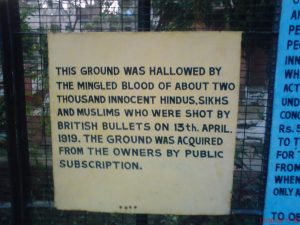General Information

Harmandir Sahib Complex, Amritsar; photo taken by Herbert Pointing; Web location: https://commons.wikimedia.org/wiki/Category:Harmandir_Sahib#/media/File:The_Golden_Temple_at_Amritsar,_by_Herbert_Ponting.jpg
Widely regarded as the most sacred site in the Sikh tradition, the city of Amritsar is known primarily for the prominent gurdwara – Sri Harmandir Sahib, “The Abode of God” – at the center of a rectangular, man-made lake. Initially begun by the 4th Sikh Guru, Ram Das, and completed by his successor, Guru Arjan, Amritsar is considered to be a place of profound spiritual importance, with the waters surrounding the temple believed to be capable of cleansing one of his or her sins after bathing in them. Constructed of white marble covered in gold leaf, the Golden Temple was built on as low an elevation as possible in an effort to emphasize the virtue of humility, and is open on all four sides to signify its acceptance of all those wishing to pay respects within its walls. While participating in services there, people remove their shoes and socks so as to not defile the ground where they walk, in addition to covering their head with cloth.
Moments of Infamy

Sign at Jallianwala Bagh, Amritsar; photo taken by Mike Lynch; Web location: https://commons.wikimedia.org/wiki/File:Jallianwala_Bagh_sign2.jpg
On April 13, 1919, a crowd of nearly 20,000 people had assembled in Jallianwala Bagh, a public garden in Amritsar, to protest against the use of violence perpetrated by the British in the Punjab region during the preceding months. Although many of those gathered were participating in the demonstration, there were also numerous pilgrims present, many from neighboring towns, who were unaware of the recently imposed martial law on the city. At 9 AM, Colonel Reginald Dyer directed British Indian soldiers to fire into the crowd, focusing fire on the exits and where people were most tightly packed together. Official reports place 379 dead, with an additional 1,200 wounded, but Indian authorities dispute these figures, with some estimates ranging as high as 1,000 dead. No order was given to those assembled to disperse; Colonel Dyer had his soldiers block the exits before firing so that individuals would not be able to escape from the area during the massacre.
More recently, in June of 1984, the Indian government engaged in Operation Blue Star, a controversial military effort to remove Jarnail Singh Bhindranwale, a Sikh extremist, and his armed followers from the Harmandir Sahib Complex in Amritsar. The operation was ordered by the prime minister at the time, Indira Gandhi, who was facing mounting pressure from her countrymen to decisively put a stop to Bhindranwale’s violence in the Punjabi countryside. From June 3rd through June 8th, Indian forces conducted military attacks on the Harmandir Sahib Complex, leaving several hundred combined casualties in their wake, including Bhindranwale. Although the Golden Temple itself suffered minimal damage, in the months that followed, soldiers from the Indian Army occupied the temple in an effort to prevent further militants from following in Bhindranwale’s footsteps. This occupation, in addition to the destruction of Akal Takht, caused widespread outrage in the Sikh community, who viewed the actions as a desecration of their most sacred city.
Additional Reading
- Dalal, Roshen. The Religions of India: A Concise Guide to Nine Major Faiths. New Delhi: Penguin Books, 2010.
- Duggal, K.S. Sikh Gurus: Their Lives & Teachings. New Delhi: UBS, 1993.
- Sayer, Derek. 1991. “British Reaction to the Amritsar Massacre 1919-1920”. Past & Present, no. 131. [Oxford University Press, Past and Present Society]: 130–64.
- Tully, Mark. “Operation Blue Star: How an Indian Army Raid on the Golden Temple Ended in Disaster.” The Telegraph, June 06, 2014. http://www.telegraph.co.uk/news/worldnews/asia/india/10881115/Operation-Blue-StarHow-an-Indian-army-raid-on-the-Golden-Temple-ended-in-disaster.html.
- Worthington, Daryl. “The Anniversary of the Amritsar Massacre.” New Historian, April 12, 2016. http://www.newhistorian.com/anniversary-amritsar-massacre/6282/.
